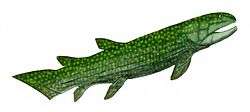Rhizodus
| Rhizodus Temporal range: 330–300 Ma | |
|---|---|
| | |
| Fossil tooth of Rhizodus hibberti | |
| Scientific classification | |
| Kingdom: | Animalia |
| Phylum: | Chordata |
| Infraphylum: | Gnathostomata |
| Class: | Osteichthyes |
| Subclass: | Sarcopterygii |
| Infraclass: | Tetrapodomorpha |
| Order: | Rhizodontida |
| Family: | Rhizodontidae |
| Genus: | Rhizodus |
Rhizodus (root tooth) is an extinct genus of rhizodont, a branch of the Sarcopterygii, the bony vertebrate clade that also includes tetrapods. It was of enormous size, reaching 6–7 metres (20–23 ft) in length.[1]
Description

The most notable characteristics of Rhizodus, when compared to other giant lobe-fins such as Barameda, were the two giant 22 cm fangs located near the front of its jaws,[2] followed by other teeth scaling downwards in size. Rhizodus was a giant apex predator that resided in freshwater lakes, river systems and large swamps in the entire Carboniferous period, feeding on small to medium-sized amphibians (ranging from 30 cm to 600 cm in size), using its teeth to kill prey and rip it into digestible sizes, rather than swallowing prey whole like other, smaller-toothed sarcopterygii.[3]
Fossil skin imprints show that Rhizodus had large, plate-like scales, similar to those found on modern day arapaimas.[4]
Distribution and habitat
Rhizodus fossils have been found in Scotland, Ireland and North America, dating back to the Early Carboniferous.[5]
Rhizodus lived in a swampy environment full of lush, tropical plants that evolved then.[6]
Diet
Rhizodus' diet includes medium sized fish and temnospondyls. It has been proposed that Rhizodus may have lunged at terrestrial, shorebound prey, just like a modern day crocodile.[7]
In popular culture
Rhizodus is featured in the forty-third episode of River Monsters, labelled "Prehistoric Terror". Host Jeremy Wade labels it as "the ultimate river monster" during his investigation due to its immense size, power and possible ferocity due to its ability to tear flesh and crush bone.[8]
References
- ↑ Rhizodus page including visual reconstruction on www.prehistoric-wildlife.com
- ↑ http://www.europeana.eu/portal/record/2022312/93D4B7C2318323299A00BD2DBFBDC3D53C65CF02.html
- ↑ http://www.twmuseums.org.uk/geofinder/search/item.php?record=NEWHM:2004.H206
- ↑ http://www.ucl.ac.uk/museums-static/obl4he/vertebratepalaeo/34_rhizodus.html
- ↑ http://www.prehistoric-wildlife.com/species/r/rhizodus.html
- ↑ http://www.prehistoric-wildlife.com/species/r/rhizodus.html
- ↑ http://www.ucl.ac.uk/museums-static/obl4he/vertebratepalaeo/34_rhizodus.html
- ↑ "Prehistoric Terror". River Monsters. 19 April 2015. Animal Planet.

